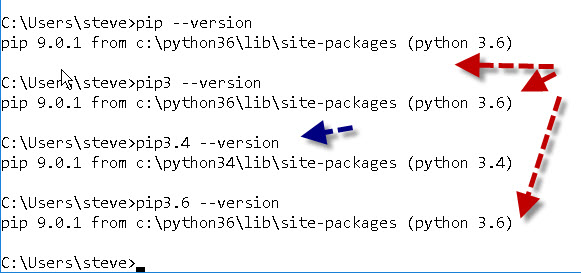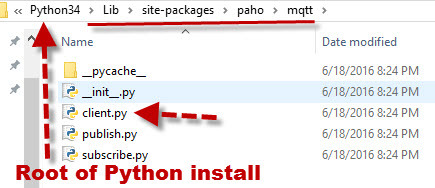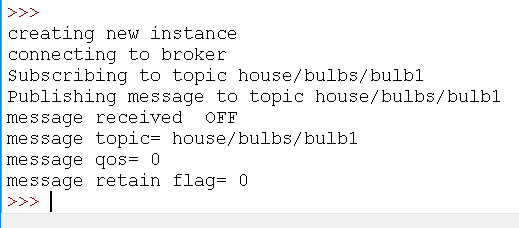How To Install Paho Mqtt In Ubuntu
The paho MQTT python client from Eclipse supports MQTT v 3.1 and 3,1.1, and now MQTTv5 and works with Python 3.x.
Tutorial Outline
In this tutorial we expect at the master customer object, and it's methods.
We will then create a uncomplicated Python instance script that subscribes to a topic and publishes messages on that topic.
If all goes well we should meet the published messages.
The example scripts are kept simple, and I don't include any error checking.
I utilize my ain locally installed banker, merely y'all will probably observe information technology easier when starting to use a free online banker similar:
- test.mosquitto.org
- broker.hivemq.com
- iot.eclipse.org
Installing The Client
You can Install the MQTT client using PIP with the command:
It ordinarily isn't every bit straightforward as using the command
pip install paho-mqtt
equally most machines accept multiple versions of python installed and there are several versions of pip and the bodily command depends on whether you are on Windows or Linux.
Therefore utilize the command:
pip --version
before installing to discover out where pip volition install the files.
The screen shot below is taken from my Windows ten machine where I take two versions of Python installed (3.iv and 3.6)

If I ran
pip install paho-mqtt
Information technology would install the client in the 3.six site packages. To install it for the 3.iv version I would need to run.
pip3.four install paho-mqtt
On my Raspberry pi (linux) using the control
pip install paho-mqtt
would install the client for use my python version 2.7

To install for version 3.5 I would demand to run:
pip3 install paho-mqtt
Note: if you have multiple versions of python on your machine and so take a look at my Python Notes.
Note: On the PI and possibly other linux versions if you get an error on install then use sudo pip install paho-mqtt.
Video- Installing The Mqtt Python Client and Other Modules Using PIP
You will detect the online client documentation here. and too the install files if y'all need them.
The Python MQTT Client
The core of the client library is the client class which provides all of the functions to publish messages and subscribe to topics.
If you want to wait at the code for this course you should find the code in the customer.py file in the mqtt directory. (windows auto)
This directory is located in python34\Lib\site-packages\paho\mqtt (windows encounter Python Notes.)
Where python34 is the root of my python install.

Main Client Methods
The paho mqtt client form has several methods.The main ones are:
- connect() and disconnect()
- subscribe() and unsubscribe()
- publish()
Each of these methods is associated with a callback. See Later.
Importing The Client Form
To employ the client class you lot demand to import it. Use the following:
Import paho.mqtt.client equally mqtt
Creating a Client Case
The client constructor takes iv optional parameters, equally shown beneath .but just the client_id is necessary, and should be unique.
Client(client_id="", clean_session=True, userdata=None, protocol=MQTTv311, transport="tcp")
To create a example use:
client =mqtt.Client(client_name)
See Working with Client objects for more details
Connecting To a Broker or Server
Before yous can publish messages or subscribe to topics y'all need to found a connectedness to a broker.
To do this apply the connect method of the Python mqtt client.
The method can exist chosen with iv parameters. The connect method declaration is shown below with the default parameters.
connect(host, port=1883, keepalive=60, bind_address="")
Note: You only need to supply the banker name/IP accost.
The general syntax is
customer.connect(host_name)
Encounter Working with Customer Connections for more than details.
Publishing Messages
Once you have a connectedness you can start to publish letters.
To do this we utilize the publish method.
The publish method accepts 4 parameters. The parameters are shown beneath with their default values.
publish(topic, payload=None, qos=0, retain=Faux)
The only parameters y'all must supply are the topic, and the payload.
The payload is the message you want to publish.
The general syntax is:
client.publish("house/low-cal","ON") Example Python Script:
We are now in a position to create our beginning Python Script to Publish a message.
The script beneath publishes the message OFF to topic house/principal-light
import paho.mqtt.client every bit mqtt #import the client1 broker_address="192.168.1.184" #broker_address="iot.eclipse.org" #use external banker client = mqtt.Client("P1") #create new example client.connect(broker_address) #connect to broker client.publish("firm/main-light","OFF")#publish Note: I am using my own local broker simply you can use an online banker similar the one at iot.eclipse.org.
Subscribing To Topics
To subscribe to a topic you use the subscribe method of the Paho MQTT Class object.
The subscribe method accepts 2 parameters – A topic or topics and a QOS (quality of Service) as shown below with their default values.
subscribe(topic, qos=0)
We volition at present subscribe to topics and in this case we volition subscribe to the topic firm/bulb1 which is also the same topic that I'm publishing on.
Doing this lets united states of america come across the letters we are publishing only nosotros will need to subscribe before nosotros publish.
So our script outline becomes.
- Create new client instance
- Connect to broker
- Subscribe to topic
- Publish bulletin
Our new example script is shown below, and I have inserted some print statements to keep rails of what is being washed.
import paho.mqtt.client every bit mqtt #import the client1 broker_address="192.168.1.184" #broker_address="iot.eclipse.org" impress("creating new instance") client = mqtt.Client("P1") #create new instance print("connecting to broker") client.connect(broker_address) #connect to banker print("Subscribing to topic","house/bulbs/bulb1") client.subscribe("house/bulbs/bulb1") impress("Publishing message to topic","business firm/bulbs/bulb1") client.publish("house/bulbs/bulb1","OFF") If we run the script this is what we come across:

So where is the bulletin that I published?
When a client subscribes to a topic information technology is basically telling the broker to send messages to information technology that are sent to the broker on that topic.
The broker is ,in upshot, publishing messages on that topic.
When the client receives messages information technology generate the on_message callback.
To view those messages we need to activate and procedure the on_message callback.
However at this phase information technology may exist ameliorate to just accept them and proceed with the script.
To process callbacks you need to:
- Create callback functions to Process any Messages
- Starting time a loop to bank check for callback messages.
The client docs describe the on_message callback and the parameters it excepts.
Here is my callback function, which basically just prints the received letters:
def on_message(client, userdata, bulletin): print("message received " ,str(message.payload.decode("utf-8"))) impress("bulletin topic=",message.topic) print("message qos=",message.qos) print("message retain flag=",bulletin.retain) Note the message parameter is a message class with members topic, qos, payload, retain.
I.e bulletin.topic will give yous the topic.
At present we demand to adhere our callback office to our client object as follows:
client.on_message=on_message #attach function to callback and finally we demand to run a loop otherwise nosotros won't see the callbacks. The simplest method is to use loop_start() as follows.
client.loop_start() #commencement the loop Nosotros also demand to stop the loop at the end of the script (loop_stop()), and in add-on await a little to give the script time to process the callback, which we attain using the time.sleep(iv) function.
This what our completed example script now looks similar:
import paho.mqtt.client every bit mqtt #import the client1 import time ############ def on_message(customer, userdata, message): print("message received " ,str(message.payload.decode("utf-8"))) print("message topic=",message.topic) print("message qos=",bulletin.qos) print("message retain flag=",bulletin.retain) ######################################## broker_address="192.168.1.184" #broker_address="iot.eclipse.org" impress("creating new case") client = mqtt.Client("P1") #create new instance client.on_message=on_message #adhere function to callback impress("connecting to banker") client.connect(broker_address) #connect to broker client.loop_start() #start the loop print("Subscribing to topic","house/bulbs/bulb1") client.subscribe("house/bulbs/bulb1") print("Publishing message to topic","house/bulbs/bulb1") client.publish("business firm/bulbs/bulb1","OFF") time.sleep(iv) # wait client.loop_stop() #stop the loop If yous run the script you should see the following

Note: logically y'all should be able to start the loop before y'all create a client connectedness, only information technology you do so you get unexpected results.
Useful Exercises
You should endeavour commenting out, one past one, the lines:
- client.on_message=on_message
- client.loop_start()
- client.Loop_stop()
and run the script to see the results.
Receiving Messages outside of the on_message Callback
A common question is how practise you lot become received messages into the main script from the on-message callback. There are several ways of doing this as explained in Receiving Messages with the Paho MQTT Python Client
Troubleshoot using Logging
To aid troubleshoot your applications y'all can use the built in customer logging callback.
To apply information technology yous create a function to process the logging callback. My function is shown below and it simply prints the log bulletin.
def on_log(client, userdata, level, buf): print("log: ",buf) and so attach it to the callback:
customer.on_log=on_log
You should then encounter details of connections,publish and subscribe messages like that shown below:

The above is a quick overview to get started you tin can find out more details in the tutorials below:
- MQTT Subscribe-Python MQTT Client Examples
- MQTT Publish-Python MQTT Client Examples
Video – Using the Paho Python MQTT Client.
Mutual Problems
1. Not seeing any letters or non seeing all expected messages.
Possible causes
- You lot haven't started a network loop or chosen the loop() part. Or you haven't registered or created the callback functions.
- You haven't subscribed to the correct topics or subscription has failed.
- Access restrictions are in place.
ii.- My letters don't appear in the order I expected?
Possible causes
- The callback functions are async functions which tin exist called at any time. Employ a queue to shop the letters and print in 1 place. I use the Python logging module.
——–> MQTT Python Beginners Course
Important Changes for MQTTv5
Although you lot may non currently exist working with MQTTv5 I would advise you to accept a look at the Client changes for MQTTv5 tutorial as past making slight changes to your code you tin can make information technology future proof.
MQTT Python Kindle Volume
If you prefer all of my MQTT pythons tutorials all in one place then y'all might be interested in my Kindle Volume.
Working with the Paho Python MQTT Customer
Related Tutorials and Resource
- MQTT overview for Beginners
- My Python Working Notes
Delight rate? And utilize Comments to permit me know more
Source: http://www.steves-internet-guide.com/into-mqtt-python-client/
Posted by: whitewarchat.blogspot.com


0 Response to "How To Install Paho Mqtt In Ubuntu"
Post a Comment